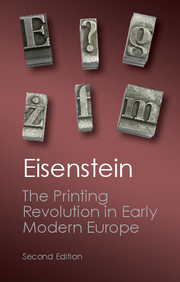Book contents
- Frontmatter
- Contents
- List of Illustrations and Maps
- Preface to the Second Edition
- Introduction
- THE PRINTING REVOLUTION IN EARLY MODERN EUROPE
- PART I THE EMERGENCE OF PRINT CULTURE IN THE WEST
- PART II INTERACTION WITH OTHER DEVELOPMENTS
- Afterword: Revisiting the Printing Revolution
- Selected Reading
- Index
Preface to the Second Edition
Published online by Cambridge University Press: 05 October 2013
- Frontmatter
- Contents
- List of Illustrations and Maps
- Preface to the Second Edition
- Introduction
- THE PRINTING REVOLUTION IN EARLY MODERN EUROPE
- PART I THE EMERGENCE OF PRINT CULTURE IN THE WEST
- PART II INTERACTION WITH OTHER DEVELOPMENTS
- Afterword: Revisiting the Printing Revolution
- Selected Reading
- Index
Summary
At the request of my publisher, I have written a review essay to serve as an “afterword” to this edition. It discusses some of the questions posed and issues raised since the publication of The Printing Press as an Agent of Change twenty-five years ago and provides references to recent studies in order to supplement the selected reading list, which has been retained from the first abridged edition.
FRONTISPIECE
The frontispiece of Prosper Marchand, Histoire de l'origine et des premiers progrés de l'imprimerie (The Hague: Pierre Paupie, 1740). The spirit of printing is shown descending from the heavens under the aegis of Minerva and Mercury. It is given first to Germany, who then presents it to Holland, England, Italy, and France (reading from left to right). Note the diverse letters from the Latin, Greek, and Hebrew alphabets decorating the draped garments of the spirit of printing. Note also the medallion portraits of master printers. Germany holds Gutenberg and Fust (Peter Schoeffer's medallion is blank); Laurens Koster represents Holland; William Caxton, England; Aldus Manutius, Italy; and Robert Estienne, France. The choice of the last, who fled Paris for Geneva after being censured by the Sorbonne, probably reflected Marchand's experience of leaving Paris for The Hague in 1707 after his conversion to Protestantism. The composition, like the book it illustrates, suggests how publishers and printers glorified their precursors while advertising themselves.
- Type
- Chapter
- Information
- The Printing Revolution in Early Modern Europe , pp. xi - xiiPublisher: Cambridge University PressPrint publication year: 2012



